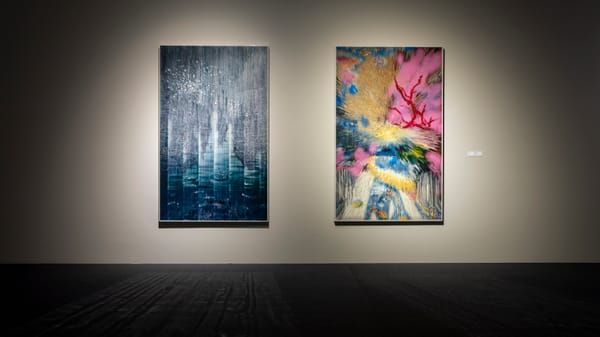Shows
Condo London 2018


In recent years, London art-goers have become used to ad hoc exhibition spaces thrown together in the cracks and crevices of the city. Thus, a former office-space on the fourth floor of a condemned tower block isn’t the strangest place to find a co-curated exhibition of works from two up-and-coming international galleries—Edouard Malingue Gallery and Mother’s Tankstation, hosted by the latter as part of the citywide event Condo London 2018. The sparsely decorated room, with its low, tiled ceiling drew a stark contrast to the planned Goldman Sachs HQ that it overlooks, but it was a fitting space for a show that, in its own words, articulated the notion of “anti-grandeur.”
The response to this idea was assembled through the use of found, cheap materials, and in addressing subject matter that avoided celebrating the historical and consequential. Works presented by French artist Eric Baudart turned to the reclamation of household debris, the barely-modified state of which suggested an exhaustion of creative processes, and a lack of narrative, which steered the focus toward the objects themselves. One wall was covered by paraSols p005 (2016), a garden umbrella whose muddy discolored fabric was flattened out so that it resembles a pressed flower; hanging next to this was Reboot 002 (2016)—a simple square of rubber mounted on an aluminum support that was in fact an old Wellington boot that had been recycled into an artwork. Ko Sin Tung’s approach likewise suggested minimal artistic effort, and presented the artist as a mere “content producer.” The work One day, workers replaced the traditional high pressure sodium street lights with the new LED ones (2017)—comprising a custom-made reflective road sign, printed with found images and streaked with a couple of lines of paint—was constructed through cursory web searches and outsourced manufacturing methods. Additionally, its unwieldy title insinuates that the editing process has been disregarded entirely.
Several works referenced the canonical rigidity of traditional fine arts, and the more subtle work that often fall outside of art books. These could be read as reasons to look beyond historical—and current—obsessions with drama and grandeur. Dublin-based Mairead O’hEocha addressed chains of reference and the burdens of historical narrative with her still-life oil-on-board Tulips Reinagle 1 (2016), a seemingly tired subject matter in an exhausted medium that is actually a reworking of a similar painting by the 18th-century artist Philip Reinagle, renowned amongst his contemporaries as a copyist of still-lifes. Shanghainese artist He Yida’s Hang – blue (2015) presented two hanging strips of plastic storage bags, one nailed to the wall, the other adhered with a strip of tape, but each free to move in slight breezes. A small amount of material filled each bag, causing them to bulge outwards, and casting a slight shadow on the wall. When studying these objects and their relationship to material and the wall, it becomes clear that these simple structures actually conform to the traditional principles of sculpture: the acknowledgement of balance; the capture of movement; and the fall of light across contoured forms.

Also referencing sculpture were four figurative works by Sam Anderson. Two small, carefully studied and molded works take inspiration from Miguel de Cervante’s Don Quixote, using the image of Sancho Panza’s donkey to stand in for the sidelined and forgotten figures of history, namely those who favor practicality and realism over idealism. Nearby, Australian painter Noel McKenna presented a number of paintings on surfaces such as ceramic tiles and plywood. His Two Homes (2016) depicts a dog kennel behind a house, his subtle sense of humor and affectation of a naïve, untrained painting style acting as a neutralizer to the political undertones of Anderson’s work.
The contemporary art scene of London is conducive to a debate of grandeur and its opposite. A vast gulf exists between the elitist galleries of the city and the majority of artists who struggle to be recognized. However, the term anti-grandeur is an open-ended one. It describes a position (against grandeur), but not its limits. This exhibition offered some potential definitions of what constitutes anti-grandeur—that which champions marginal or overlooked subjects through familiar forms—and in doing so, offers a foundation on which to build a critique of the present moment, where grandeur in all its forms is celebrated as a virtue.
Condo London 2018 takes place across London until February 10, 2018. The exhibition at Mother’s Tankstation is on view until February 17, 2018.







